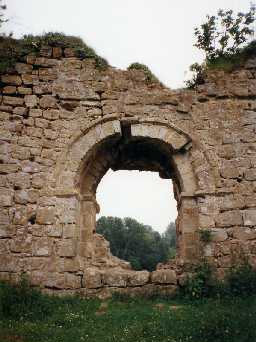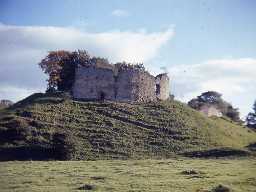Mitford Castle (Mitford)
(NZ 17048547) Mitford Castle (Remains of). (1)
Pointed oval bailey with strong counterscarp bank and outworks, with a similar-shaped low motte on one side. The top of the motte is surrounded by a high D-shaped shell-wall, within which is a pentagonal keep. The southern half of the bailey was walled. Excavations inside the bailey in 1938 revealed a mid-12th century chapel covering an earlier burial ground. Mentioned in 1138, and confiscated by the king in 1215. (2)
The castle is in a very ruinous condition, with some parts in danger of collapse. Two headstones (now in Mitford churchyard) were recovered by the Rev Stirk from the old quarry at the south end of the castle (see illustrations). (3)
Condition unchanged. (4)
Grade I Mitford Castle
Scheduled Ancient Monument. Very picturesque, forms part of an important group of the Church, Manor House and Bridge. Cream stone walls in fragmentary condition on a mound opposite the Church. 12th and 13th centuries, with tunnel vaults in basement. (5)
Mitford Castle. Stands on a natural sandstone hill, scarped and heightened to form a motte and bailey castle. To the north is the River Wansbeck, to the east and south the Park Burn, and a moat protects the west side.
Shell keep built on motte. Traces of buildings inside the walls can still be seen. Small five-sided keep built in 13th century, inside shell keep. The only five-sided keep in England; the walls of the shell keep formed an inner bailey. Only remains of keep is the vaulted basement.
The south of the bailey has been quarried away, remains of a chapel left. Barmkin beyond north wall, now all traces gone. Last occupants left before 1327; never restored since. (6)
North part of enclosed area is higher than the rest and parted off by a cross wall. In this inner ward is the Norman keep, 36ft square - north side has two faces making the keep five-sided. Walls c.7ft thick. All the keep above the ground floor walls is destroyed. The inner ward was entered by a small strong doorway in the cross wall.
The outer ward had a probable chapel on its south side - many graves, some covered with slabs, and one containing a stone coffin, were uncovered when baring for the quarry. Main entrance to outer ward was on the east commanded by the keep. (7)
(10/16) Mitford Castle, remains of inner ward and keep. Grade I listed building. Late 11th century earthwork fortress of the Bertram family. Inner curtain wall early 12th century; outer ward and chapel late 12th century; keep early 13th century. Described as the 'oppidum' of William Bertram in 1138. Seized by Flemish troops of King John in 1215. It was the scene of kidnappings in 1315 by Sir Gilbert de Middleton. Described as 'wholly burned' in 1327; not certain if it was ever restored.
(9/17) Mitford Castle, remains of west curtain wall buildings. Grade I listed building. Curtain wall and adjacent structures. 12th and 13th century. Three length of wall showing different builds and masonry types.
(10/18) Mitford Castle, remains of east curtain wall. Grade I listed building. 12th and 13th century. Gateway to barmkin, mural chambers, garderobe and round arch.
(10/19) Mitford Castle, remains of chapel in outer ward. Grade I listed building. Mid 12th century chapel, largely destroyed by quarrying in the early 19th century.
(10/20) Mitford Castle, two headstones to north of chapel ruin. Grade I listed. Probably early 12th century. Part of a cemetery with several sepulchral monuments in situ, uncovered in 1939. Other stones removed or destroyed by vandals. (8)
Scheduled National Number 32728. (9)
A programme of recording work was carried out in 2002 in advance of consolidation works to the castle. This included a structural survey (by P Ryder) and a brief history of the site. The castle is almost unique in that, whilst extensive structural remains of the 12th and 13th centuries survive, there is hardly any evidence at all of later medieval or post-medieval interference, apart from some antiquarian repairs. (10)
A third water spout was found in the shell keep during archaeological monitoring in 2006. (11)
Some of the main elements of this complex are visible as earthworks and structures on historical and recent air photos and on lidar imagery. (12) (13)
NZ 170 855. Mitford Castle. Scheduled No ND/73. (14a)
Listed by Cathcart King. (14b)
By 1115 William Bertram and his wife were living in the newly-built motte and bailey at Mitford. In 1166 the timber-work was being replaced in stone, which was not completed until 1215. Mitford became notorious as the centre of activities of the `Mitford Castle Gang' in 1315-17. Local landowners, led by Thomas, the Earl of Lancaster, terrorised local farmers into either joining their protection racket, or being imprisoned at Mitford and having their land and stock siezed and relatives outcast or murdered. Most of the Gang were captured in December 1317 and executed. Robert the Bruce siezed Mitford and put it in the charge of Walter Selby, one of the Mitford Gang who had escaped cature. In 1321 he surrendered Mitford to the sheriff of Northumberland, after which the castle went into disuse. (14c)
Pointed oval bailey with strong counterscarp bank and outworks, with a similar-shaped low motte on one side. The top of the motte is surrounded by a high D-shaped shell-wall, within which is a pentagonal keep. The southern half of the bailey was walled. Excavations inside the bailey in 1938 revealed a mid-12th century chapel covering an earlier burial ground. Mentioned in 1138, and confiscated by the king in 1215. (2)
The castle is in a very ruinous condition, with some parts in danger of collapse. Two headstones (now in Mitford churchyard) were recovered by the Rev Stirk from the old quarry at the south end of the castle (see illustrations). (3)
Condition unchanged. (4)
Grade I Mitford Castle
Scheduled Ancient Monument. Very picturesque, forms part of an important group of the Church, Manor House and Bridge. Cream stone walls in fragmentary condition on a mound opposite the Church. 12th and 13th centuries, with tunnel vaults in basement. (5)
Mitford Castle. Stands on a natural sandstone hill, scarped and heightened to form a motte and bailey castle. To the north is the River Wansbeck, to the east and south the Park Burn, and a moat protects the west side.
Shell keep built on motte. Traces of buildings inside the walls can still be seen. Small five-sided keep built in 13th century, inside shell keep. The only five-sided keep in England; the walls of the shell keep formed an inner bailey. Only remains of keep is the vaulted basement.
The south of the bailey has been quarried away, remains of a chapel left. Barmkin beyond north wall, now all traces gone. Last occupants left before 1327; never restored since. (6)
North part of enclosed area is higher than the rest and parted off by a cross wall. In this inner ward is the Norman keep, 36ft square - north side has two faces making the keep five-sided. Walls c.7ft thick. All the keep above the ground floor walls is destroyed. The inner ward was entered by a small strong doorway in the cross wall.
The outer ward had a probable chapel on its south side - many graves, some covered with slabs, and one containing a stone coffin, were uncovered when baring for the quarry. Main entrance to outer ward was on the east commanded by the keep. (7)
(10/16) Mitford Castle, remains of inner ward and keep. Grade I listed building. Late 11th century earthwork fortress of the Bertram family. Inner curtain wall early 12th century; outer ward and chapel late 12th century; keep early 13th century. Described as the 'oppidum' of William Bertram in 1138. Seized by Flemish troops of King John in 1215. It was the scene of kidnappings in 1315 by Sir Gilbert de Middleton. Described as 'wholly burned' in 1327; not certain if it was ever restored.
(9/17) Mitford Castle, remains of west curtain wall buildings. Grade I listed building. Curtain wall and adjacent structures. 12th and 13th century. Three length of wall showing different builds and masonry types.
(10/18) Mitford Castle, remains of east curtain wall. Grade I listed building. 12th and 13th century. Gateway to barmkin, mural chambers, garderobe and round arch.
(10/19) Mitford Castle, remains of chapel in outer ward. Grade I listed building. Mid 12th century chapel, largely destroyed by quarrying in the early 19th century.
(10/20) Mitford Castle, two headstones to north of chapel ruin. Grade I listed. Probably early 12th century. Part of a cemetery with several sepulchral monuments in situ, uncovered in 1939. Other stones removed or destroyed by vandals. (8)
Scheduled National Number 32728. (9)
A programme of recording work was carried out in 2002 in advance of consolidation works to the castle. This included a structural survey (by P Ryder) and a brief history of the site. The castle is almost unique in that, whilst extensive structural remains of the 12th and 13th centuries survive, there is hardly any evidence at all of later medieval or post-medieval interference, apart from some antiquarian repairs. (10)
A third water spout was found in the shell keep during archaeological monitoring in 2006. (11)
Some of the main elements of this complex are visible as earthworks and structures on historical and recent air photos and on lidar imagery. (12) (13)
NZ 170 855. Mitford Castle. Scheduled No ND/73. (14a)
Listed by Cathcart King. (14b)
By 1115 William Bertram and his wife were living in the newly-built motte and bailey at Mitford. In 1166 the timber-work was being replaced in stone, which was not completed until 1215. Mitford became notorious as the centre of activities of the `Mitford Castle Gang' in 1315-17. Local landowners, led by Thomas, the Earl of Lancaster, terrorised local farmers into either joining their protection racket, or being imprisoned at Mitford and having their land and stock siezed and relatives outcast or murdered. Most of the Gang were captured in December 1317 and executed. Robert the Bruce siezed Mitford and put it in the charge of Walter Selby, one of the Mitford Gang who had escaped cature. In 1321 he surrendered Mitford to the sheriff of Northumberland, after which the castle went into disuse. (14c)
N11067
EXCAVATION, Mitford Castle 1939
FIELD OBSERVATION, Ordnance Survey Archaeology Division Field Investigation 1954; E Geary
FIELD OBSERVATION, Ordnance Survey Archaeology Division Field Investigation 1971; B H Pritchard
BUILDING SURVEY, Mitford Castle structural survey and documentary study 2002; The Archaeological Practice
WATCHING BRIEF, Mitford Castle Conservation 2004; The Archaeological Practice Ltd
WATCHING BRIEF, Mitford Castle Conservation Project phase 1 2005; The Archaeological Practice Ltd
WATCHING BRIEF, Mitford Castle Conservation Project phase 2 2006; The Archaeological Practice Ltd
ARCHITECTURAL SURVEY, Investigation by RCHME/EH Architectural Survey ; RCHME
FIELD OBSERVATION, Ordnance Survey Archaeology Division Field Investigation 1954; E Geary
FIELD OBSERVATION, Ordnance Survey Archaeology Division Field Investigation 1971; B H Pritchard
BUILDING SURVEY, Mitford Castle structural survey and documentary study 2002; The Archaeological Practice
WATCHING BRIEF, Mitford Castle Conservation 2004; The Archaeological Practice Ltd
WATCHING BRIEF, Mitford Castle Conservation Project phase 1 2005; The Archaeological Practice Ltd
WATCHING BRIEF, Mitford Castle Conservation Project phase 2 2006; The Archaeological Practice Ltd
ARCHITECTURAL SURVEY, Investigation by RCHME/EH Architectural Survey ; RCHME
Disclaimer -
Please note that this information has been compiled from a number of different sources. Durham County Council and Northumberland County Council can accept no responsibility for any inaccuracy contained therein. If you wish to use/copy any of the images, please ensure that you read the Copyright information provided.

